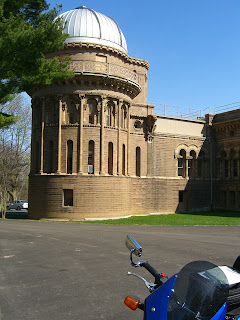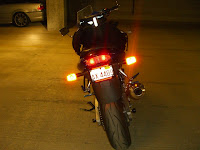
Rather than spend last weekend (my original plan) in WI, I spent Sunday riding around a massive lot for six hours. The weather could not have been better! Still, Sunday started out a bit shaky. I was a wee bit tired--but in a good way--after having spent much of Saturday riding to and from WI. By Sunday morning, something I had eaten Saturday in Harvard, IL, was making my stomach rebel. Still, I didn’t want to miss the hard work and fun that awaited me in Ride-Chicago's SRTT (Street Rider Technical Training) class, which I had taken last year. I rode the 13 miles to Maywood, trying to ignore the unpleasant rumbling in my gut.
When I arrived at the range, I was met by an assortment of colorful, serious-looking bikes. In my first SRTT class, the bikes appeared tamer, some nakeds, several cruisers and a couple of Goldwings. While sport bikes seemed to dominate this class, we had a diverse mix. Don Helle, teacher par excellence, is the instructor. In addition, teachers from Ride-Chicago were on hand to assist.
It doesn’t’ take long to know that Don is a master rider. He rides an aptly colored yellow and black Yammie FZ1, which makes me thing of a zip-zagging bumblebee. Don has garnered many awards for his riding and teaching and I’m sorry I can’t list them here (next time I’ll have to interview him at the end of the class). I do know that while in the military, Don was in charge of teaching motorcycle safety. I know his riding and teaching has transcended North America to include international ventures. He advocates superior skills, particularly Japanese style street riding techniques. Don is a demanding, clever instructor who knows that so much of effective teaching is relationship-building. Before you know it, you’re sucked into his circle; you’re convinced that mastering the skills and techniques he teaches are achievable and potentially life saving. Basic motorcycle safety skills, which you need to take this course, scratch the surface in the vast world of motorcycle riding. We know, that the more we practice, the more proficient we become. But at some point, many of us will want to deepen our knowledge and hone our skills with a track day, private lessons, experienced riders course or an advanced “super” course like SRTT. It is a demanding, doable step-up regardless of one’s current skill level.

Whole body riding is key to SRTT style. The class is about developing confidence-inspiring skills, being in absolute control of one’s machine; it’s about efficiency, maximizing stability, and becoming a highly skilled motorcyclist. As Ride-Chicago states, it’s about riding “with” the motorcycle and not “on” the motorcycle.

Many of us rely on upper body strength to maneuver our bikes. For the most part, this works. Before you finish SRTT class, however, you realize how much more efficient riding is that incorporates the whole body. Think of all that unused power in the lower body. It’s a different ride altogether when you’re cornering in full body synchronization. Thus, the class commences with stretching exercises to loosen up the joints and get mentally prepared for riding. A pre-class suggestion recommends taking an Advil before class. I was smart, this time around, I did. Don always bets that by 2pm the aches and discomfort will be palpable to some of us. Really, it’ll be the next two days before you stop walking as if you’re imitating John Wayne.

After riding the vast lot to warm up self and tires, our first lesson is braking. My explanation will probably not do justice to the technique, but here goes: When learning to ride, I was taught to ease off the throttle (engine braking), disengage the clutch, and apply both brakes simultaneously. SRTT teaches a solid, firm application of the brakes just before you hear/feel that unmistakable sound of the bike beginning to peter, at which point, you pull in the clutch and downshift to first gear. Don gave a convincing, technical explanation of why this method is superior to what most of us are traditionally taught. I can’t explain it better than I have. I know this: it feels better, more certain and definitive, more streamlined and far more efficient. That skill alone is worth the $105 tuition!
Get a good night's sleep before the course as the class requires almost continuous riding around a massive space that is marked off with cones and directional arrows that create a maze of real-road challenges. Thus, learning the route is the first challenge. I zoned out and lost my way a few times, which of course, throws off anyone trailing you. The class is devoid of long queues of bikes waiting for their time on the course. Sunday’s class had more than a dozen bikes buzzing about the range together the whole day. I never felt crunched for space or time. By the end of class, even with pulling out for 15 minutes to settle my churning stomach and to fret over a sore thumb, my odometer registered more than 45 miles.

Considerable time is devoted to proper cornering in tight spaces. After hearing Don’s sound instructions on entering, braking, and accelerating--all of which are executed at specific points--we spent significant time applying these skills. Some of the more talented riders (and there were a lot in this class) inhaled the technique and demonstrated it early and easily. I understood the theory and the technique, but I was stuck a bit in basic cornering technique, which works, but I needed to step-up. It took me many attempts to sorta put it all together. I didn’t mastered it with the precision, smoothness and gracefulness that seemed second nature to some of the others. These riders seemed to fly into the marked space, brake on a dime by applying both brakes, turn their head at exactly the right point, get off the front brake (while staying on the back brake) and accelerate to the next corner. The entire course had its share of cornering opportunities but these particular corners were set up back-to-back. It was challenging, yet fun. I ended the class feeling that I had greatly improved my cornering skills but still had a lot to learn. That’s the beauty of SRTT, no matter the level at which you begin the class, you end it feeling like a highly improved rider.

I can’t forget the straight-line cone weave. Not a problem, right? Well, the goal isn’t just about getting through. None of us had a problem with that. Yet, many of us managed the cones by working harder than necessary because we depended heavily on our ability to steer the bike around the cones, ignoring the power inherent in our lower body. This is where the whole-body riding shines. Don said if done properly, our knees would move up and down as we navigated around the cones. Sure enough, while watching one group, we could observe some of them bowling through with nary a move from the hip/knee region, and others who seemed to be marching as their bikes flicked flawlessly around the little orange domes.
Riding with both hands firmly on the handlebars is what motorcyclists do. Imagine riding the entire course with one hand. Last year, I remembered liking this a lot. But I had forgotten how exacting it was. One hand riding makes you acutely aware of how often we compensate for flaws in our skills by using both hands. One hand riding demands that you think ahead and prepare yourself for what’s coming up next; it forces you to be precise and on point with your head turns; it requires you to exercise smooth throttle control; it makes you deliberate in using whole-body riding. Without the use of both hands, you automatically call upon all your resources to help you ride; thus, your lower regions are activated to assist. One hand riding around a challenging course is also mental and you’ll be amazed at just how good a rider it renders you and how aware you’ll become of the need to put your whole self into riding.

The class doesn’t end before Don takes everyone on a ride on his Yammie. Even though it may feel like it, the goal is not to make you pray for divine intervention. The objective is to help the passenger feel how to ride the course by riding with a master. Anyone who has ridden two-up with Don knows that it is an understatement to call it "an amazing experience." Having had the ride the previous year, I knew what was in store for the unsuspecting participants and I did my part to encourage them to take the ride. I did not ride with Don. Not because I didn’t want my turn but because my stomach warned me not to. I imagined going down in Ride-Chicago history as the woman who upchucked on Don during SRTT—I would never live that down.

It’s not just a ride. It’s an experience. You come away with a tangible sense of how it feels to execute a flawless corner, how it feels to control speed, how it feels to stop on a dime, how it feels to make your bike seem as if it is being held upright by an invisible string, you feel what real leaning is and how proper throttle use maintains stability. It’s hard to convey, but I know this: after you ride with Don and return to riding the course, you'll see that your riding has changed and greatly improved because you’ve felt what it feels like to do it right and in seeking that same feeling in your own riding, you ride so much better than before.
The class ends with Don introducing us to riding with no hands (beyond straight line riding) and teaching us four rather showy but important skills, one of which is said to help enhance your love life (well, sorta). Of these, I love the bump and roll and the Chicago stop/California stop (I heard it said both ways). All in all a magnificent day and one that I’ll repeat each year to mark the beginning of a new riding season.
















